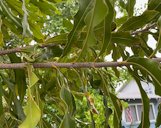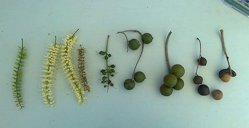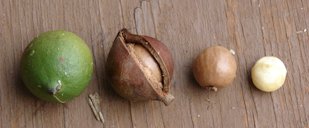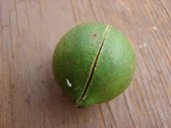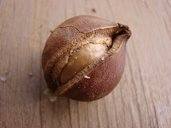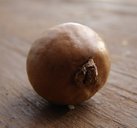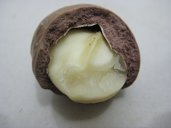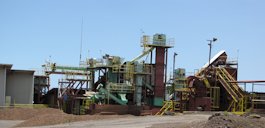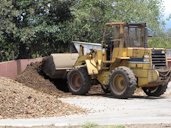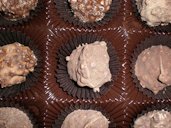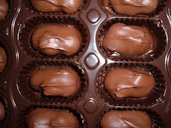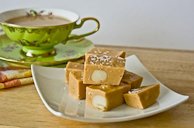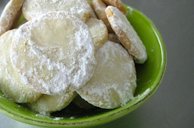| Macadamia, Smooth-Shell - Macadamia integrifolia | |||||||||||||||||||||||||||||||||||||||||||
|---|---|---|---|---|---|---|---|---|---|---|---|---|---|---|---|---|---|---|---|---|---|---|---|---|---|---|---|---|---|---|---|---|---|---|---|---|---|---|---|---|---|---|---|
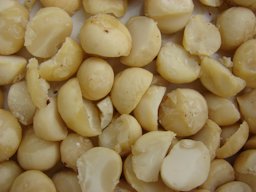 Fig. 1  Macadamia integrifolia (macadamia nut), Makawao, Maui, Hawai'i  Fig. 2  Fresh macadamia nuts. Inside the green skin is a brown tough shell. You need to crack the shell and take out the nuts; eat them raw or roasted. 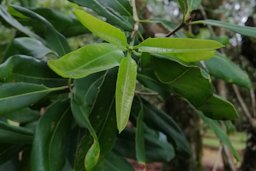 Fig. 3  New flush on M. integrifolia “Own Choice” variety  Fig. 4 M. integrifolia, leaf from a mature tree 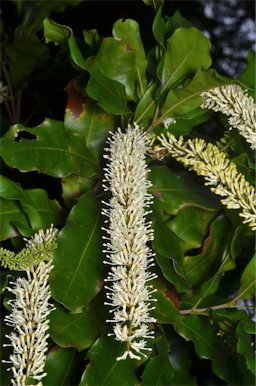 Fig. 9  M. integrifolia near Hervey Range Heritage Tea Rooms, East of Townsville, QLD 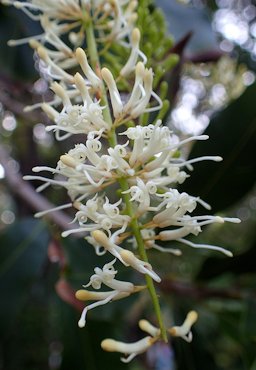 Fig. 10  M. integrifolia in Jardín de Aclimatación de la Orotava, Spain  Fig. 11  Macadamia flowering, North Coast Regional Botanic Garden, Coffs Harbour, NSW Australia 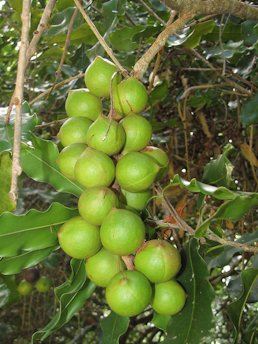 Fig. 13  Fruit, MISC HQ Piiholo, Maui, Hawai'i 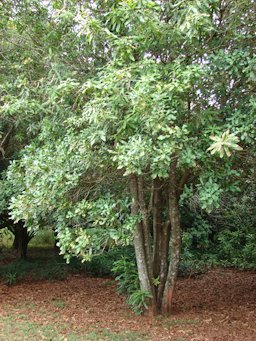 Fig. 19  Tree habit, MISC HQ Piiholo, Maui, Hawai'i 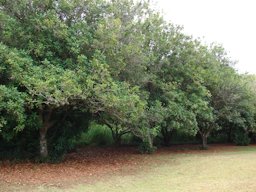 Fig. 20  Row of trees, MISC HQ Piiholo, Maui, Hawai'i  Fig. 21  Nuts on ground, Kula Botanical Garden, Maui, Hawai'i 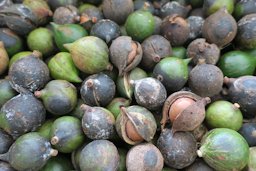 Fig. 22  M. integrifolia ‘Own Choice’, Sydney, Australia 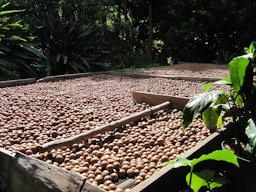 Fig. 23  Macadamia nuts drying in the sun 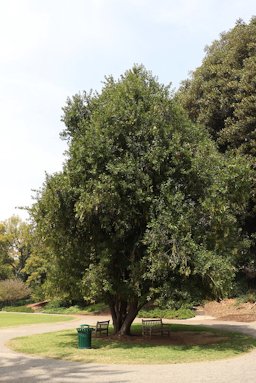 Fig. 27  M. integrifolia, San Marino, Huntington, CA 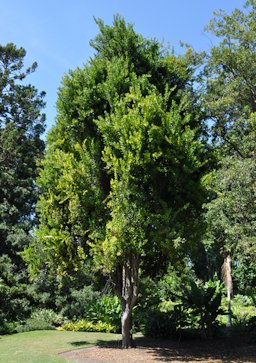 Fig. 28  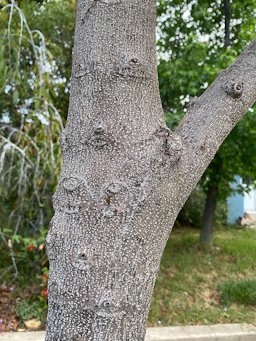 Fig. 29  M. integrifolia bark  Fig. 30  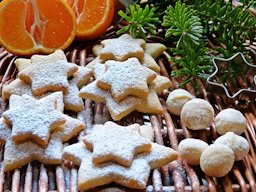 Fig. 31  macadamia cookies  Fig. 32  Macadamia tarts, Europa cakes, Acland St, St Kilda, Melbourne, Australia 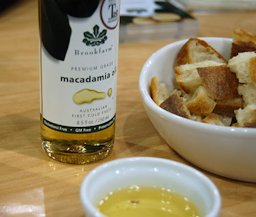 Fig. 38 Macadamia oil. NASFT 52nd New York Summer Fancy Food show 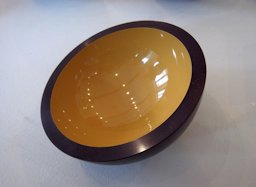 Fig. 39 Bowls made from macadamia husk, marketed as 'Husque' |
Scientific
name Macadamia integrifolia Maiden & Betche Pronunciation mak-uh-DAY-mee-a in-teg-ree-FOH-lee-uh Common names English: Bauple nut, bopplenut, bush nut, macadamia, nut-oak, popple nut, Queenslandnut; French: macadamier, noix de Queensland; German: echte Macadamianut, glattschalige Macadamia, Macadamianut, Queenslandnut; Portuguese: macadâmia, nogueira-do-havaí; Spanish: macadamia; Swedish: trubbmacadamia; Transcribed Chinese: ao zhou jian guo 1 Synonyms M. ternifolia var. integrifolia Maiden & Betche 1,5 Family Proteaceae (protea family) Origin Native to coastal rainforests of south-eastern Queensland and north-eastern New South Wales Australia 3,5 USDA hardiness zones 9-12 15,21 Uses Food; oil; shade; ornemental; cosmetics Height Native area: 60 ft (18 m); in Florida: 35 ft (11 m) 6,19 Spread Up to 40 ft (12 m) 6 Crown Dense; rounded Plant habit Flowering nut tree; erect (Fig. 27) or spreading Growth rate Slow Longevity Trees introduced in Hawai'i in the late 1800's are still bearing; 40-60 years estimated productive life 20 Trunk/bark/branches Short; bark rough but not furrowed; grayish-brown; without buttress roots 19,24 Pruning requirement Training early to establish strong framework with central leader 20 Leaves Evergreen; thick; leathery; oblong to lanceolate; 4-10 in. (10-25 cm) long; nodal whorls of three 10,24 Flowers Showy; white; small; pendulous; borne on long racemes; Jan., Feb. through late spring 8 Fruit Hard, woody, globose follicle with a pointed apex; edible creamy white kernel Season July-Dec.; some strains almost ever-bearing 8,10 USDA Nutrient Content pdf Light requirement Sun Soil tolerances Can be grown in a wide range of soils including poor soils, but not on heavy, impermeable clays, saline or calcareous soils 2 pH preference 5.0-6.0; tolerating 4.5-7.0 2,5 Drought tolerances Mature trees are drought tolerant Soil salt tolerance Will not tolerate soil or water with high salt concentrations Wind tolerance The brittle wood makes it susceptible to wind damage 2 Cold tolerance Mature trees tolerate 25-26 °F (3-5 °C) for short periods 10 Min. temp. 21 °F (-6 °C); Max. temp. 77 °F (25 °C) 12 Plant spacing In California, trees are planted 18 ft (5.5 m) apart; in Hawai'i 30-36ft (9-11 m) apart 17 Roots Deep taproot and relatively few lateral roots 3 Invasive potential * None reported Pest/disease resistance Few diseases or pests in Florida Known hazard Macadamia nuts are toxic to dogs Reading Material Queensland Nut Tree, Macadamia integrifolia, Heathy Land and Water pdf Macadamia integrifolia, Agroforestree Database Macadamia nuts, Australian nuts, Handbook of Energy Crops Macadamia, Crop Knowledge Master, University of Hawai'i Macadamia integrifolia Maiden & Betche, PROSEA Foundation Macadamia integrifolia (the 'Papershell' macadamia), Archives of the Rare Fruit Council of Australia Macadamia Nut, Tropical Fruit News, RFCI Origin The macadamia is the only commercial food crop indigenous to Australia, originating in the rain forests of south-eastern Queensland and north-eastern New South Wales. Although a plantation had already been established in Australia as early as 1888, the University of Hawai'i developed its potential in the 1930s. But not until the 1950s did the Hawai'ian success encourage other countries to grow macadamia on a commercial scale. Since 1970, the area under cultivation has expanded rapidly, with extensive plantings in many tropical countries. Close to the equator, macadamia is grown commercially in eastern Africa. 5,12 Some countries in Latin America, Africa and Asia also grow macadamia nuts. In the continental United States, trees are found in California and Florida. 4 Botany The Proteaceae family has about 55 genera and approximately 1200 species. It is one of the most consistent families in terms of consistent characteristics. Most of the species have a 4-parted perianth, showy racemes, 4 stamens and the fruit is usually a nut. The Macadamia genus all have whorled leaves, small bisexual flowers and a fruit which is a hard, round drupe or nut. 17 Description There are 2 species that produce edible kernels, "Smooth-shell Macadamia" (Macadamia integrifolia), and "Rough-shell Macadamia" (Macadamia tetraphylla). Hybrid forms exist between the two species. Both species are attractive, medium sized, evergreen trees; with age they often attain a height of 60 feet or more, and a spread of about 40 feet.They have shiny, green, holly-like foliage, and grafted trees of selected varieties make attractive, shapely specimens well worth growing as combination ornamental, shade, and nut tree. M. integrifolia, the only commercially important species, commonly known as "smooth-shell" macadamia, has proven suitable for large-scale processing as a high-quality dessert nut. 6 Macadamia tetraphylla L.A.S. Johnson also produces edible kernels and is also cultivated. It differs from Macadamia integrifolia by its always spiny leaves, usually occurring in whorls of 4, up to 50 cm long, often sessile (petiole up to 3 mm), pink flowers and a rough-shelled nut. In Australia, it occupies a more southern area than Macadamia integrifolia. 5 Macadamia (Macadamia integrifolia) is one of few nut trees well adapted for Florida. Of the 40 or more cuItivars that are presently available, only a few are well adapted for Florida. Probably the best thing is to take selected seedlings which have been grown here rather than try and bring introduced cultivars from other areas. 8 A quick guide to macadamia identification, Macadamia Conservation Trust pdf Macadamia Nuts in Hawai'i: History and Production, University of Hawai'i at Mānoa pdf Leaves The shiny, oblong leaves are 4 to 10 inches long, characteristically borne in whorls of 3 at a node. Margins of leaves of older trees are usually smooth (Fig. 4,6), but those of young trees are frequently spiny (Fig. 5). New growth is light-green to bronze in color, changing to shiny dark green with maturity. Growth occurs in a series of flushes in warmer months. 6,13 Three buds arranged longitudinally in the axil of each leaf usually only the top bud shoots out, making a sharply acute angle with the trunk. 12
Fig. 5. M. integrifolia seedling, Queensland, AU Fig. 8. M. integrifolia, stem Flowers Floral initiation takes place when temperatures drop and trees become quiescent in autumn, the optimum temperature being 65 °F (18 °C). The initials remain dormant for 50-96 days; the racemes extend after a rise in temperature and some rain. 2 The small, perfect, cream-colored flowers are borne in axillary racemes 6 to 12 inches long consisting of several hundred flowers. Although there are a large number of flowers in each raceme, usually not more than about 10 nuts set and mature. 6 Trees flower for 3 to 12 months, various strains produce fruits over a long period. Some cvs have a definite fruiting season. 3 Flowering generally occurs on wood that is at least 2 years old. 20
Fig. 12. M. integrifolia flower and nut maturation progression Pollination Flowers are protandrous (male organs mature before the female) with maximum pollen germination 3 days after anthesis. 13 Pollination is by insects; most cultivars are at least partly self-incompatible. Planting pollinator trees and introducing bees are important for good fruit set. Fruitlets continue to be shed up to 2 months after bloom. 2 Fruit Botanically, the macadamia fruit is a dehiscent follicle. Macadamia fruits consist of the dull-green pericarp (Fig. 14), (known commercially as the husk), the testa (Fig. 15) (or shell) and the embryo (or kernel). 21 The dull-green pericarp (husk), splits along a single suture (Fig. 14); it darkens as it matures (Fig. 15). 'Nut’ or the commercial term ‘nut-in-shell’ is used to refer to the seed (Fig. 16), i.e., the seed coat or ‘shell’ containing the embryo, or ‘kernel’. 21 The edible part, or kernel, is the creamy white embryo containing about 80 percent oil and 4 percent sugar when dry. 6 The shell (Fig. 16) material is five times harder than hazelnut shells and has mechanical properties similar to aluminum. 11
Fig. 14. Fruit of the macadamia nut in different stages, Makawao, Maui, Hawai'i Fig. 15. Green nut with shell barely cracked (husk) Fig. 16. Mature husk showing hard inner shell, Makawao, Maui, Hawai'i Fig. 17. Nut-in-shell, husk removed Fig. 18. Macadamia nut-in-shell variety 344 (or 'Kau') Varieties In Florida, high yields is the most important consideration. Four cultivars are recommended: 'Dana White', a productive cultivar selected in Homestead; 'Beaumont', a hybrid selected in Australia with spiny leaves, pink flowers, and reasonable productivity; 'Arkin Papershell', a productive cultivar that produces a high-quality nut; and 'Cate', a commercial cultivar selected in California. 19 The 'Papershell' macadamia is a name coined by Morris Arkin to describe the thinner shell obtained from a seedling of Macadamia integrifolia. It has all the qualities of a fine macadamia nut plus the advantages of easier opening and being comfortable in the climate of Southern Florida. 17 Harvesting About 215 days after flowering, macadamia fruit (or nut-in-husk) fall to the ground and are harvested by hand or mechanically from the ground. The fibrous pericarp (husk) is removed by a mechanical dehusker. Nut-in-shell (botanically, the seeds) are then dried to 10% moisture content, transported to the factory for processing, further dried to 3% moisture content, cracked and processed. 9,21 If the nuts were picked and cannot be husked nor delivered to the processor, then the in-husk nuts should be dried within 24 hours of harvest. Failure to do so initiates undesirable physiological activity which causes fermentation and spoilage. The in-husk nuts should be spread on a wire or slotted rack out of the rain and direct sun (Fig. 22). 4,9 Processing After the nuts have been removed from their shells they are graded. Fresh nuts are placed into a saline bath of specific gravity 1.024. If they float they are placed into a water bath. The nuts that rise to the surface (72% oil content or more) are classed as grade I nuts and are packaged as "Top Quality Edible Nuts". Those that sink are classed as grade II nuts and are sold whole for edible purposes. 9 The nuts that sink during the first immersion are placed into another saline bath which has a specific gravity of 1.15. If they float they are graded as Grade III and are used for oil extraction. 9
Fig. 26. Processing plant, Pahala, Hawai'i, Hawai'i Fig. 25. Processing in action tractor moving nuts Principals of Extraction, Food And Agriculture Organization of the United Nations Macadamia Technical Information, © INC - International Nut and Dried Fruit Council, www.nutfruit.org pdf Macadamia Nuts, Minor Oil Crops, Food And Agriculture Organization of the United Nations Propagation Propagation by seed is not difficult, but seedlings are variable in production and nut characteristics, and so of little value for commercial plantings. Freshly harvested nuts are best for germination, but require 30–90 days before germination. Propagation usually by cuttings, marcottage and side-tongue grafts. Rootstocks for grafting are readily grown from seed by ordinary nursery means. Grafting in Macadamia is more difficult than in most nut trees due to hardness of wood. Best results obtained when seedling rootstocks are side-wedge grafted with selected scions. 3 Grafters girdle the branches to accumulate starch for several weeks before harvesting the branches as scion. 20 It takes about 2 years to produce grafted trees of suitable size for transplanting. This is figured from the time the seed for rootstocks is planted, until the grafted trees are large enough for transplanting into the orchard. 23 Grafted macadamia nut trees can start bearing a small crop in the fifth year after planting, and full production is reached in 12 to 15 years. 22 Grafting Macadamia Trees in Hawai‘i, University of Hawai'i at Mānoa pdf
Culture The xerophytic characteristics of the tree, including the sclerophyllous leaves and proteoid roots (dense clusters of rootlets formed to explore poor soils low in phosphorus) suggest adaptation to relatively harsh environments. However, the conditions required for optimum production may be quite different from those for survival. 2 Although macadamia trees tolerate and survive mild frosts and drought conditions, yield and quality are adversely affected. Macadamia trees are considered susceptible to wind damage and do best where there is good, natural wind protection or adequate planted windbreaks. There have been some indications that temperatures over 90 °F (32 °C) reduce production and growth. 6 Trees prefer well-drained locations and in areas that are subject to flooding, will often develop root rot or grow poorly. 8 They should be planted in full sun but will tolerate some shade as their origin is as an understory tree. 13 Macadamia climatic requirements are similar to Mexican or Guatemalan races of the avocado. 14
Fig. 26. Wind damage to crops during recent storm in Kainaliu, Hawai'i Pruning The object of pruning a macadamia is to form a tree with a single main stem and a framework of horizontal branches, starting at 3 ft. above the ground and from there at intervals of about 1-1/2 ft. In M. integrifolia there are 3 buds in a vertical row in each of the three leaf axils of a node. When the stem is topped, all three upper buds will grow straight up. Only one of them must be allowed to remain and to continue the main stem, the other two being clipped off to a stub of about 3/8 inch. Now the buds below those two stubs will grow out in a more or less horizontal direction. Only these branches will flower and fruit. This process is repeated until a good framework has been established. Macadamias will take heavy pruning but this may drastically reduces yields. 7 Little pruning is required in bearing trees except to discourage leaders, to reduce lateral growth, to let in light, and to make cultural and harvesting operations more favorable. Pruning should be done toward end of winter after crop is harvested. 3 Branches can be brittle in strong winds. This can be alleviated by selective pruning of weak narrow crotch angle branches and appropriate sheltering. 13
Fertilizing Macadamia-growing areas differ widely with regard to soil type and chemistry, tree age and planting density, therefor fertilizer application recommendations vary greatly. 20 In the calcareous soils of south Florida, they are likely to suffer from zinc, manganese, and iron deficiencies. Nutritional sprays will control the first two. However, iron chlorosis is only corrected by soil applications of chelates especially formulated for these soils. 10 Irrigation Once a dry period induces fruit set, they need water for proper maturation. 13 When there is less than 50 inches of well-distributed annual rainfall, supplementary irrigation is beneficial since moisture stress can cause reduction in yield and quality of nuts. 6 Pests/Diseases About the only major pest of the tree, at least in South Florida, are various types of animals such as rats and squirrels that cause substantial losses of the nuts. Some nut borers in a few local areas are becoming a problem and a few fungus problems such as anthracnose are showing up in some areas. At the present time, most trees have to sprayed very little, if at all, for pests and diseases. 8 Premature nut drop - most premature drop is normal, environmental stress may cause more premature drop than normal. 4 Food Uses The fine, crunchy texture, rich cream colour and delicate flavour make the macadamia nut one of the finest dessert nuts. The eating quality of the nut is enhanced by lightly roasting it in coconut oil and salting. Raw kernels are also popular alone or in a wide range of confectionery and processed foods. 2 The highest quality macadamia kernels are free of defects and insect and fungal damage, and they contain at least 72% oil. Kernels with less than 72% oil are usually immature and harder, and they become over brown when roasted. 4 Macadamia oil (or macadamia nut oil) is the non-volatile oil collected from the nuts . It is used in food as a frying or salad oil. They can be ground into a flour and then added to cereals to enrich their protein value. 15
Fig. 33. Kona Krunch chocolate covered macadamia nuts with rice crisp Fig. 34. Chocolate-covered macadamia nuts Fig. 35. Roasted salted nuts Fig. 36. To die for salted caramel macadamia nut fudge Fig. 37. Key lime macadamia nut cookies with white chocolate glaze Macadamias, Australia's Contribution, Barry's Nutrition Report, Rare Fruit Council WA Processing Macadamia Nuts at Home, University of Hawai'i at Mānoa pdf Macadamia: Hawai'i's dessert nut, University of Hawai'i at Mānoa pdf Medicinal Properties ** The oil in macadamias is largely monounsaturated fat, similar to olive oil and other nuts which have been a traditional part of Mediterranean diets. The monounsaturated fatty acid content of macadamia kernels is higher than found in other tree nuts including almonds, Brazil nuts, cashews, pecans, walnuts, pistachios and hazelnuts. The 80.5% mono-unsaturated of fat content of macadamia nut oil also compares favourably to olive oil, which has a monounsaturated fat content of 74%. 20 Several dietary studies on the beneficial effects of macadamia consumption have been conducted and have demonstrated improvement in cholesterol and blood fats through a significant reduction in total blood serum cholesterol and low-density lipoprotein (LDL) cholesterol. 20 Other Uses • Oil can be extracted from culled nuts. The cosmetic industry, especially in Japan, uses the oil in soaps, sunscreens and shampoos. 4 • Apiculture: Macadamia pollen is very attractive to bees, providing necessary forage for honey production. Macadamia shells may be used as fuel, generating sufficient energy to dry wet, in-shell nuts. 2 • Shade or shelter: M. integrifolia makes an excellent evergreen shade and shelter due to its thick crown of leaves. 2 • Tannin or dyestuff: The hulls, the green covering of the nuts, contain approximately 14% of substances suitable for tanning leather. 2 • Lipids: Macadamia is the richest oil-yielding nut known. The kernel contains more than 75% oil, suitable for human consumption. 2 • Essential oil: The characteristic, subtle macadamia flavour is probably due to volatile compounds, the major ones being similar to those in other roasted nuts. 2 • Ornamental: As well as being an evergreen nut-bearing tree, M. integrifolia has good symmetrical shape and when in full bloom is covered with creamy-white and pinkish flowers in long, narrow, drooping racemes. These make it a popular ornamental tree. 2 General The genus is named after J. Macadam (1827-1865), secretary of the philosophical Institute of Victoria. The specific name integrifolia is from the Latin integri-‘entire’ and folium-‘a leaf’ in allusion to the grouping of leaves in whorls of four. 2 The sweetness of fresh macadamia nuts from the M. tetraphylla x integrifolia hybrids usually grown in California makes it unnecessary to salt them, though a few growers roast and salt nuts in the same manner that Hawai'ian or Central American producers do. The flavor of California produced macadamias is excellent, and it is a major advantage for growers. The Mediterranean climate and soils of southern California differ significantly from those of other macadamia producing areas. These differences are reflected in the dominance of Macadamia tetraphylla x integrifolia hybrid cultivars in California. 14 Pet hyacinth macaws, Anodorhynchus hyacinthinus, are often fed macadamias, since they can break the hard nuts with their strong beaks. These large parrots are one of the few animals, aside from humans, capable of cracking and shelling the nut. 16 Gold Crown Macadamia Association's No. 1 customer happens to be owners of exotic birds, primarily macaws, which need the macadamia's tough shells to chew on to prevent their beaks from getting soft. 18 Macadamia nuts are of material and cultural importance to Aboriginal people. They are eaten whole or pressed to produce oil that is used as a liniment base or as a binder for ochres and clays used for face and body decoration and artwork. 24 Indigenous Australian names for the tree include gyndl, jindilli, and boombera. 17 All four species of Macadamia are listed as threatened under Queensland, New South Wales and Commonwealth legislation and are listed in the International Union for the Conservation of Nature and Natural Resources (IUCN) 1997 Red List for Threatened Plants. 25 Bill Whitman introduced the Macadamia integrifolia 'Keahou' (Hawai'i) to Florida in 1954. Other Edible in the macadamia Genus Rough-Shell Macadamia, M. tetraphylla Further Reading Domestication and Commercialisation, West Australian Nut and Tree Crops Association INC - International Nut and Dried Fruit Council ext. link Macadamia, California Rare Fruit Growers Macadamia Conservation Trust ext. link Macadamia Nuts: Not just a product of Hawai'i, California Farm Bureau Federation Macadamia Nut Economic Fact Sheet, University of Hawai'i CTAHR pdf Macadamia Production in Southern California, Progress in New Crops, Purdue University The Bopple Nut, Bauple Museum pdf Macadamia Toxicity in Dogs, Sub-Tropical Fruit Club of Qld Older Material Growing Macadamia Nuts in Hawai'i, 1959, University of Hawai'i, Hawai'i Agricultural Experiment Station pdf List of Growers and Vendors |
||||||||||||||||||||||||||||||||||||||||||
| Bibliography 1 "Macadamia integrifolia Maiden & Betche." The Plant List (2013), Version 1.1, www.theplantlist.org. Accessed 11 Dec. 2020. 2 Orwa, C., et al. "Macadamia integrifolia Maiden et Betche." Agroforestree Database: a tree reference and selection guide, version 4.0, 2009, Agroforestry, apps.worldagroforestry.org/treedb2/speciesprofile.php?Spid=1091. Accessed 27 Sept. 2021. 3 Duke, James A. "Macadamia integrifolia Maiden & Betche, Macadamia tetraphylla L. Johnson." Handbook of Energy Crops, Purdue University, Center for New Crops and Plant Products, unpublished, 1983, NewCROP™, hort.purdue.edu/newcrop/duke_energy/Macadamia.html. Accessed 27 Sept. 2021. 4 Bittenbender, H. C., and H. H. Hirae, et al. "Macadamia." Crop Knowledge Master, University of Hawai'i, Extension Service, Aug. 1992, extento.hawaii.edu/kbase/crop/crops/i_macada.htm. Accessed27 Sept. 2021. 5 Stephenson, R. A., and C. W. Winks. "Macadamia integrifolia Maiden & Betche." Edible fruits and nuts, Plant Resources of South-East Asia No 2, Edited by E. W. M. Verheij and R. E. Coronel, PROSEA Foundation, Bogor, Indonesia, record 1530,1991, PROSEA, (CC BY-NC-SA 3.0), www.prota4u.org/prosea/view.aspx?id=1516. Accessed 27 Sept. 2021. 6 Hamilton, R. A., et al. "Macadamia: Hawai'i's dessert nut." University of Hawai'i, Circular No 485, 1983, CTAHR, www.ctahr.hawaii.edu/oc/freepubs/pdf/C1-485.pdf. Accessed 27 Sept. 2021. 7 "Macadamia." California Rare Fruit Growers, 1997, crfg.org. Accessed 13 May 2014, 27 Sept. 2021. 8 Joyner, Gene. Macadamia Nut. Rare Fruit Council International Miami RFCI, Tropical Fruit News, 1988. 9 Axtell, B. L. "Macadamia Nuts." Minor Oil Crops, Individual monographs, FAO Agricultural Bulletin No. 94, Research by R. M. Fairman, Food And Agriculture Organization of the United Nations, 1992, FAO, www.fao.org/3/X5043E/x5043E09.htm. Accessed 27 Sept. 2021. 10 Malo, S. E., and C. W. Campbell. "The Macadamia." Horticultural Sciences Dept., UF/IFAS Extension, FC9, Original pub. Apr. 1994, Reviewed Nov. 2005 and Nov. 2009, archived, EDIS, ufdc.ufl.edu/IR00003392/00001. Accessed 27 Sept. 2021. 11 "Macadamia." Wikipedia, en.wikipedia.org/wiki/Macadamia. Accessed 27 Sept. 2021. 12 "Macadamia integrifolia Maiden et Betche." Tree Species, ICRAF's Tree Functional Attributes and Ecological Database, db.worldagroforestry.org//species/properties/Macadamia_integrifolia. Accessed 27 Sept. 2021. 13 "Macadamia, Queensland Nut." The Rare Fruit Club WA, www.rarefruitclub.org.au/Macadamia.htm. Accessed 27 Sept. 2021. 14 McHargue, Lawrence T. "Macadamia Production in Southern California." Progress in New Crops, Edited by J. Janick, pp. 458-462, 1996, NewCROP™, hort.purdue.edu/newcrop/proceedings1996/V3-458.html. Accessed 27 Sept. 2021. 15 "Macadamia integrifolia - Maiden.&Betche." Pants For A Future, (CC BY-NC-SA 4.0), PFAF, pfaf.org/user/Plant.aspx?LatinName=Macadamia+integrifolia. Accessed 27 Sept. 2021. 16 "Macadamia." New World Encyclopedia, (CC BY-SA 3.0), www.newworldencyclopedia.org/entry/Macadamia. Accessed 27 Sept. 2021. 17 Rosenstein, R. "Macadamia integrifolia (the 'Papershell' macadamia)." Archives of the Rare Fruit Council of Australia, Extract from Tropical Fruit News - August, 1990, July 1991, rfcarchives.org.au/Next/Fruits/Nuts/Macadamia7-91.htm. Accessed 27 Sept. 2021. 18 Lee, Ching. "Macadamia nuts: Not just a product of Hawai'i." California Farm Bureau Federation, 9 Jan. 2008, www.agalert.com/story/?id=963. Accessed 27 Sept. 2021. 19 Boning, Charles R. Florida's Best Fruiting Plants- Native and Exotic Trees, Shrubs, and Vines. Sarasota, Pineapple Press, 2006. 20 The Encyclopedia of Fruit & Nuts. Edited by Jules Janick and Robert E. Paull, Cambridge, CABI, 2008. 21 Wallace, H. M., and D. A. Walton. "Macadamia (Macadamia integrifolia, Macadamia tetraphylla and hybrids)." Postharvest biology and technology of tropical and subtropical fruits Volume 3: Cocona to mango, 2011, ZLibrary, b-ok.cc/book/1187553/f944f4. Accessed 27 Sept. 2021. 22 Hamilton, R. A., and E. T. Fukunaga. "Growing Macadamia Nuts in Hawai'i." University of Hawai'i, Hawai'i Agricultural Experiment Station, Bulletin 121, Jan. 1959, ScholarSpace, scholarspace.manoa.hawaii.edu/handle/10125/15280. Accessed 27 Sept. 2021. 23 Yokoyama, Kevin M., et al. "Macadamia Nut." Dept. of Agricultural and Resource Economics, College of Tropical Agriculture and Human Resources, University of Hawai'i, Economic Fact Sheet no. 9, Sept. 1990, ScholarSpace, scholarspace.manoa.hawaii.edu/bitstream/10125/54677/CtahrpsEconFact9MacNut.pdf. Accessed 27 Sept. 2021. 24 Ryan, S. "Queensland nut tree Macadamia integrifolia." Ecosystem Conservation Branch, Queenland Govt., Conservation Services Division, 2006, www.qld.gov.au. Accessed 27 Sept. 2021. 25 "Why conserve Macadamias?" macadamia Conservation Trust, www.wildmacadamias.org.au. Accessed 27 Sept. 2021. Videos v1 "Easy method for graft Macadamia - How to graft Macadamia." Avocado Diary, 20 June 2020, (CC0), www.youtube.com/watch?v=-Wi3YpVfNsg. Accessed 9 July 2021. v2 "Macadamia graft result after several months." Avocado Diary, 23 June 2020, (CC0), www.youtube.com/watch?v=rjtOq66CE2Y. Accessed 9 July 2021. v3 du Preez, Alwynn. "Pruning a young macadamia orchard." Golden Macadamias, (CC0), www.youtube.com/watch?v=q9jn2MzQ-_E. Accessed 9 July 2021. Photographs Fig. 1 Starr, Forest, and Kim. "Macadamia integrifolia (Macadamia nut). Nuts, Makawao, Maui, Hawai'i." Starr Environmental, no. 081111-0452, 11 Nov. 2008, (CC BY 4.0), www.starrenvironmental.com/images/image/?q=24631301940. Accessed 17 Dec. 2020. Fig. 2 Kang, Sherry. "Fresh macadamia nuts." Flickr, 5 Mar. 2005, (CC BY 2.0), www.flickr.com/photos/43323141@N00/6100811. Accessed 15 Dec. 2020. Fig. 3 Bond, Denise. "New flush on Macadamia integrifolia “Own Choice” variety." Denise Bond private collection. Accessed 7 Dec. 2021. Fig. 4,5,6,7 Tasney, Greg. "Macadamia Tree Macadamia integrifolia. Queensland, AU." iNaturalist, Research Grade Observations, 25 Oct. 2020, (CC BY-NC 4.0), www.inaturalist.org/observations/63466773. Accessed 16 Dec. 2020. Fig. 8,28,29,30 SelecTree. "Macadamia integrifolia Tree Record."1995-2020, selectree.calpoly.edu/tree-detail/macadamia-integrifolia. Accessed Dec 18, 2020. Fig. 9 Fagg, M. "Macadamia integrifolia. Near Hervey Range Heritage Tea Rooms, c. 38 km E of Townsville, QLD.” Australian Plant Image Index (APII), dig. 43899, Australian National Botanic Gardens, Australian Government, Canberra, 21 Sept. 2016, ANBG, www.anbg.gov.au/cgi-bin/phtml?pc=dig&pn=43899. Accessed 16 Dec. 2020. Fig. 10 Ziarnek, Krzysztof. "Macadamia integrifolia in Jardín de Aclimatación de la Orotava." Wikimedia Commons, 3 Feb. 2016, (CC BY-SA 4.0), commons.wikimedia.org/wiki/File:Macadamia_integrifolia_kz3.JPG. Accessed 16 Dec. 2020. Fig. 11 Tatters. "Macadamia flowering, North Coast Regional Botanic Garden, Coffs Harbour, NSW Australia." Flickr, 12 Sept. 2019, (CC BY-SA 2.0), www.flickr.com/search/?user_id=62938898%40N00&view_all=1&text=Macadamia integrifolia. Accessed 18 Dec. 2020. Fig. 12 "Macadamia integrifolia flower and nut maturation progression." Macadamia Conservation Trust, www.wildmacadamias.org.au/rare-macadamias/the-four-macadamias/. Accessed 7 Dec. 2021. Fig. 13 Starr, Forest, and Kim. "Macadamia integrifolia (Macadamia nut). Fruit. MISC HQ Piiholo, Maui, Hawai'i." Starr Environmental, no. 090804-3777, 4 Aug. 2009, (CC BY 4.0), www.starrenvironmental.com/images/image/?q=24675785870. Accessed 17 Dec. 2020. Fig. 14 Starr, Forest, and Kim. "Macadamia integrifolia (Macadamia nut). Different stages. Makawao, Maui, Hawai'i." Starr Environmental, no. 081111-0455, 11 Nov. 2008, (CC BY 4.0), Image Cropped, www.starrenvironmental.com/images/image/?q=24299912723. Accessed 17 Dec. 2020. Fig. 15 Starr, Forest, and Kim. "Macadamia integrifolia (Macadamia nut). Green nut with shell barely cracked. Makawao, Maui, Hawai'i." Starr Environmental, no. 081111-0466, 11 Nov. 2008, (CC BY 4.0), Image Cropped, www.starrenvironmental.com/images/image/?q=24926787575. Accessed 17 Dec. 2020. Fig. 16 Starr, Forest, and Kim. "Macadamia integrifolia (Macadamia nut). Nut with shell cracked. Makawao, Maui, Hawai'i." Starr Environmental, no. 081111-0464, 11 Nov. 2008, (CC BY 4.0), Image Cropped, www.starrenvironmental.com/images/image/?q=24900488186. Accessed 17 Dec. 2020. Fig. 17 Starr, Forest, and Kim. "Macadamia integrifolia (Macadamia nut). Nut with inner shell, Makawao, Maui, Hawai'i." Starr Environmental, no. 081111-0463, 11 Nov. 2008, (CC BY 4.0), www.starrenvironmental.com/images/image/?q=24299927253. Accessed 21 Dec. 2020. Fig. 18 Salazar, Esteban. "General Macadamia nut image Variety 344 (or 'Kau') may look different." Daleys Fruit Tree Nursery, (CC BY-SA 2.0), plant.daleysfruit.com.au/trees/m/Macadamia-Bush-Nut-2177.jpeg. Accessed 21 Dec. 2020. Fig. 19 Starr, Forest, and Kim. "Macadamia integrifolia (Macadamia nut). Tree habit, MISC HQ Piiholo, Maui, Hawai'i." Starr Environmental, no. 080715-9219, 15 July 2008, (CC BY 4.0), www.starrenvironmental.com/images/image/?q=24296705603. Accessed 17 Dec. 2020. Fig. 20 Starr, Forest, and Kim. "Macadamia integrifolia (Macadamia nut). Row of trees, MISC HQ Piiholo, Maui, Hawai'i." Starr Environmental, no. 080715-9233, 15 July 2008, (CC BY 4.0), www.starrenvironmental.com/images/image/?q=24555983819. Accessed 17 Dec. 2020. Fig. 21 Starr, Forest, and Kim. "Macadamia integrifolia (Macadamia nut). Nuts on ground, Kula Botanical Garden, Maui, Hawai'i." Starr Environmental, no. 110307-2715, 7 Mar. 2011, (CC BY 4.0), www.starrenvironmental.com/images/image/?q=24447928604. Accessed 17 Dec. 2020. Fig. 22 "Macadamia integrifolia ‘Own Choice’." Flickr, Royal Botanic Garden Sydney, 15 May 2018, (CC BY-NC-ND 2.0), www.flickr.com/photos/44616272@N03/30046161638. Accessed 18 Dec. 2020. Fig. 23 josephhill. Pixabay, 11 Nov. 2012, Public Domain, pixabay.com/photos/macadamia-nut-organic-harvest-nuts-912598/. Accessed 16 Dec. 2020. Fig. 24 Starr, Forest, and Kim. "Macadamia integrifolia (Macadamia nut). Processing plant, Pahala, Hawai'i." Starr Environmental, no. 120717-8899, 17 July 2012, (CC BY 4.0), Image Cropped, www.starrenvironmental.com/images/image/?q=25162177556. Accessed 17 Dec. 2020. Fig. 25 Starr, Forest, and Kim. "Macadamia integrifolia (Macadamia nut). Processing in action tractor moving nuts, Pahala, Hawai'i." Starr Environmental, no. 120717-8896, 17 July 2012, (CC BY 4.0), www.starrenvironmental.com/images/image/?q=25162172256. Accessed 17 Dec. 2020. Fig. 26 Kawabata, Andrea. "Macadamia integrifolia. Wind damage to crops during recent storm in Kainaliu, Hawai'i." Flickr, via Scot Nelson, 3 Jan. 2015, Public Domain, www.flickr.com/search/?user_id=62295966%40N07&view_all=1&text=Macadamia integrifolia. Accessed 18 Dec. 2020. Fig. 27 Martirosyan, Vahe. "Macadamia integrifolia, San Marino, Huntington, CA." Flickr, 5 Apr. 2018, (CC BY-SA 2.0), www.flickr.com/photos/gsanjose/187617993/. Accessed 18 Dec. 2020. Fig. 31 silviarita. Pixabay, 11 Nov. 2016, Public Domain, pixabay.com/photos/cookie-christmas-advent-macadamia-1817286/. Accessed 16 Dec. 2020. Fig. 32 Jackmanson, David. "Macadamia Tarts, Europa Cakes, Acland St, St Kilda, Melbourne, Australia." Flickr, 7 Dec. 2009, (CC BY 2.0), www.flickr.com/photos/58301516@N00/4166221814. Accessed 18 Dec. 2020. Fig. 33 BrokenSphere. "Kona Krunch chocolate covered macadamia nuts with rice crisp." Wikimedia Commons, 30 Mar. 2008, (CC BY-SA 2.5), (CC BY-SA 2.0), (CC BY-SA 1.0), GFDL, commons.wikimedia.org/wiki/File:Kona_Krunch_chocolate_covered_macadamias_with_rice_crisp.JPG. Accessed 18 Dec. 2020. Fig. 34 BrokenSphere. "Chocolate-covered macadamia nuts." Wikimedia Commons, 21 Jan. 2008, (CC BY-SA 2.5), (CC BY-SA 2.0), (CC BY-SA 1.0), GFDL, commons.wikimedia.org/wiki/File:Macadamia_integrifolia_kz3.JPG. Accessed 18 Dec. 2020. Fig. 35 Merz, Jessica. "Tasty, tasty macadamia nuts." Flickr, via Scot Nelson, 9 Dec. 2005, (CC BY 2.0), www.flickr.com/photos/94953676@N00/71922690. Accessed 18 Dec. 2020. Fig. 36 Voodoo Kitchen. "To Die For Salted Caramel Macadamia Nut Fudge." Foodista, 1 Nov. 2013, (CC BY 3.0), www.foodista.com/blog/2013/11/01/to-die-for-salted-caramel-macadamia-nut-fudge. Accessed 18 Dec. 2020. Fig. 37 add1sun. "Key Lime Macadamia Nut Cookies With White Chocolate Glaze." Foodista, 18 Dec. 2011, (CC BY 3.0), www.foodista.com/blog/2011/12/18/12-days-of-holiday-cookies-key-lime-macadamia-nut-cookies-day-4. Accessed 18 Dec. 2020. Fig. 38 San Jose, Gerald. "Macadamia oil. NASFT 52nd New York Summer Fancy Food Show." Flickr, 9 July 2006, (CC BY 2.0), www.flickr.com/photos/gsanjose/187617993/. Accessed 15 Dec. 2020. Fig. 39 Fagg, M. "Bowls made from Macadamia husk, marketed as 'Husque' by Marc Harrison.” Australian Plant Image Index (APII), dig. 26467, Australian National Botanic Gardens, Australian Government, Canberra, 24 July 2011, ANBG, www.anbg.gov.au/cgi-bin/phtml?pc=dig&pn=26467. Accessed 16 Dec. 2020. * UF/IFAS Assessment of Non-native Plants in Florida's Natural Areas ** Information provided is not intended to be used as a guide for treatment of medical conditions. Published 27 Sept. 2021 LR. Last update 7 Dec. 2021 LR |
|||||||||||||||||||||||||||||||||||||||||||



